To use a vulgar phrase, I can’t get my head around this exhibition. It seems anything but ‘vulgar’. Daintily laid out and dimly lit in the gloomier cloisters of Fortress Barbican is a series of dresses — the chaps hardly get a look-in, save for some of those white-knee-britched, jaboty, gold-laced-coat get-ups that people like Philip Green struggle into for their fancy-dress parties — some ancient, some modern, a lot very pretty, a few laughably ludicrous; anyone wanting a frightening clown costume for Halloween will find inspiration here. The clothes are, for the most part, exquisitely made. Many are elegant, and several supremely extravagant; however, the organisers of the exhibition seem to be trying to lump them all into the ‘vulgar’ basket. Which seems odd.
The earliest shown, those wide-panniered ‘infanta’ skirts (for keeping one’s dwarf under?) with bosom-eliminating bodices, miraculous with their glittering appliquéd embroidery on wonderfully dull-coloured silks, are clearly works of art as much as fashion — as indeed are some of, say, Galliano’s more extreme confections — but are they vulgar? There must have been a reason why they wanted this fantastic extreme silhouette. It could possibly have been religious. Did the Spanish court, where they originated, see their monarchs as being the embracers of their people, who could metaphorically shelter under those skirts, the Queen of Heaven protecting her flock?
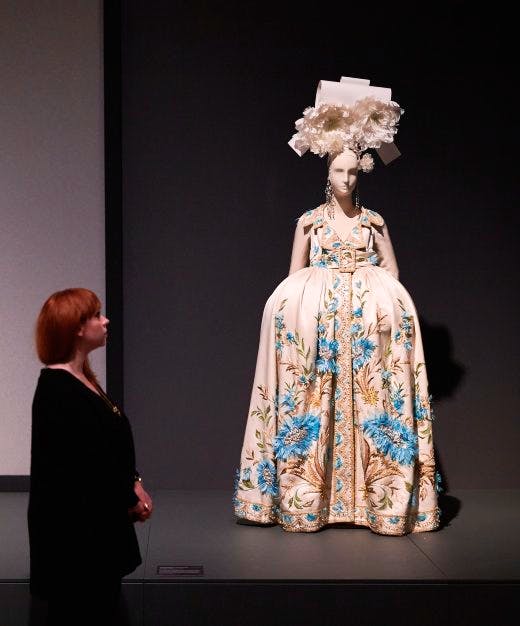
An ‘Infanta’ dress at the Barbican’s exhibition ‘The Vulgar’. Photo: © Michael Bowles / Getty Images
There is almost always a reason why fashions evolve, just as in interior decoration; if one analyses the early shape of panelling — a rectangle with the corners scooped out — one realises that it’s the shape of the animal hides our ancestors tacked up in their draughty stone huts. Columns are tree trunks, their capitals foliage, and so on.
There are a trio, if indeed you can see them in the murk, of peasant dresses from the Auvergne, refreshingly simple and perhaps the nearest thing to vulgar in its true sense of being ‘echt’, or grass-rooted. Advance a couple of centuries and Paco Rabanne’s cream minidress, couture’s antithesis of vulgar, stripped down much farther than Chanel ever dreamed of, is in the same galère, and a bit more shocking in its simplicity than any of the fantasy frou-frou that the next wave of designers indulged in. And I was pleased that my dear friend Rudi Gernreich, astonishingly one of only two Americans included — the other being Charles James, whose witty Snow White-print dress long predates the Warhol-stolen Campbell’s Soup stuff — is represented by the very same tweed ‘big pants’, with nothing but narrow ribbon braces, that I’d had photographed on Rudi’s muse and model, Peggy Claxton, for a spread in the US magazine I art-edited in the early 1960s. It was the first totally topless fashion photo ever printed.
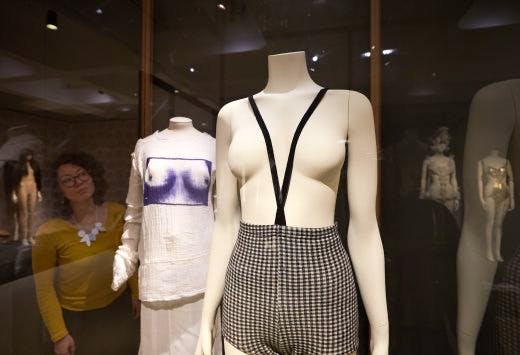
Rudi Gernreich’s tweed ‘big pants’ at the Barbican’s exhibition ‘The Vulgar’. Photo: © Michael Bowles / Getty Images
There was a hue and cry at its publication. Many were shocked, but it wasn’t actually considered vulgar. Maybe the vulgar can’t be shocking, or the shocking vulgar. Vulgar is a weak current, boring, even; the shocking knocks your socks off. That is to a certain extent demonstrated by the most outré outfits the exhibition leads up to. We’ve known for years that they are rather marvellous, but they seem new now only because, as no customers ever seriously wore them, they were forgotten by all but fashion geeks — and were in any case created purely to get the paparazzi photo-op that would push the scent and sunglasses to the masses. Selling scraps of dreams: perhaps that is vulgar. And speaking of dreams, there’s not a mention anywhere of Hollywood, where the clothes of Adrian, Omar Kiam and Travis Banton influenced not only European designers, but also women (and hence ‘the vulgar’) worldwide. If this exhibition had been done in the Diana Vreeland/Met mode there would have been some life to it, some eye-opening fizz, rather than textbook familiarity.
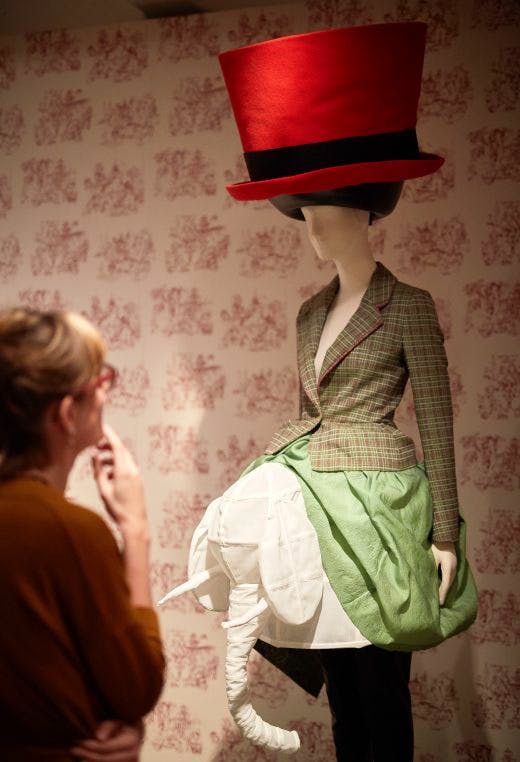
Installation shot of the Barbican’s exhibition ‘The Vulgar’. Photo: © Michael Bowles / Getty Images
But is anything vulgar anymore? There’s a quote by the curator Adam Phillips inscribed on one wall stating, ‘Vulgar is the common tongue,’ and here he has a point. Vulgarity has become the norm, even a sought-after quality. No one these days says, ‘They’re/that’s so vulgar.’ It would be far too un-PC. Women smoking in the street was considered vulgar in my youth, now it’s about the only place they can. Wearing too few clothes in public isn’t vulgar, nor is swearing, nor joking about death or illness. Being overweight is a ‘problem’, not vulgar, noisy children are just ‘expressing themselves’. Architects’ ghastly new buildings go up without critical comment; appearing in rubber and bondage in public has taken the fun out of fetishism. One simply shrugs at the rock-bottom level of comedy on radio shows. Anna Wintour puts the Kardashians on the cover of Vogue; trillionaires’ mega-yachts are envied, flashy lifestyles the fodder of tabloids; sportsmen spraying champagne is considered amusing. Restaurants with names like Sexy Fish get a nod-nod wink-wink.
It would be a relief if something actually was vulgar. Personally, I think Bake Off takes the vulgarity biscuit. I can’t explain why. It just does. It’s something to do with safeness, with appealing to the lowest common denominator. Maybe that’s the message I missed in the show.
Got something to add? Join the discussion and comment below.
Get 10 issues for just $10
Subscribe to The Spectator Australia today for the next 10 magazine issues, plus full online access, for just $10.

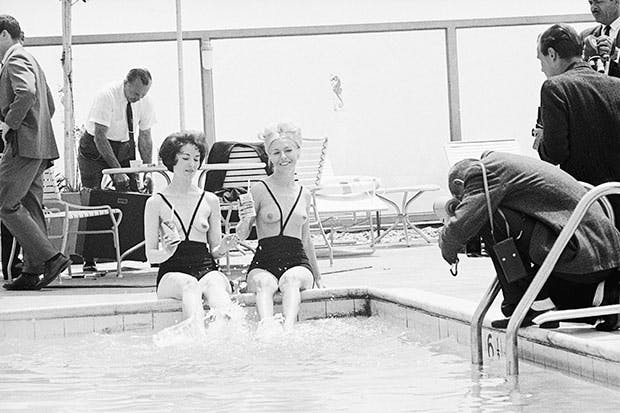
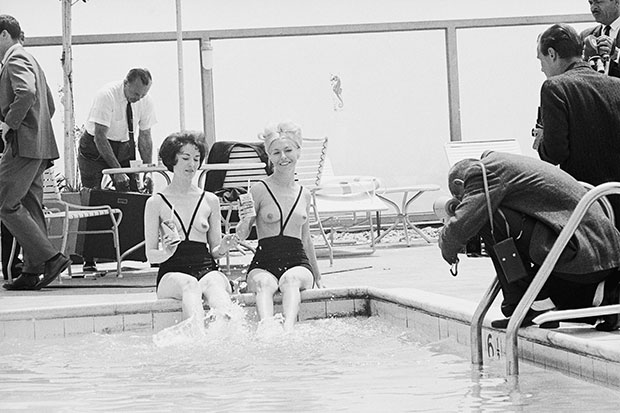


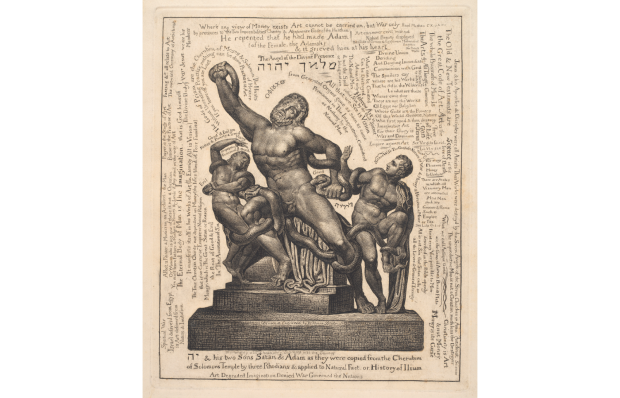








Comments
Don't miss out
Join the conversation with other Spectator Australia readers. Subscribe to leave a comment.
SUBSCRIBEAlready a subscriber? Log in